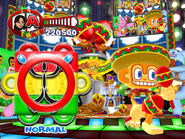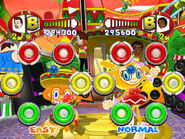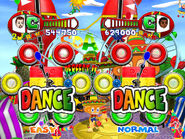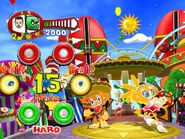Samba de Amigo is a rhythm game developed by Sonic Team and released in 1999 by Sega in arcades, and in 2000 for the Dreamcast video game console. The player uses a special type of controller, the maraca controller with the goal of matching a series of patterns displayed onscreen. It can be played by one or two players simultaneously.
On February 8th 2023, a Nintendo Switch sequel called Samba De Amigo: Party Central was announced and will release in Summer of 2023.
Gameplay[]
Samba de Amigo is played with a pair of maracas. As a song plays, the player guided by on-screen graphics must shake the maracas at high, middle, or low heights with the beat of the music, or occasionally must strike poses with the maracas held in various positions. The player is represented on-screen by "Amigo", a grinning monkey with a square head and a sombrero. If the player does well, the scene around the monkey usually a concert or a dance will attract more people and become more vividly animated; if the player does poorly, characters leave and eventually all that's left is the monkey alone, looking sad.
In the primary game mode, each player has six spots arranged in a circle on the screen: two red meaning 'shake high,' two yellow meaning 'shake middle,' and two green meaning 'shake low.' Blue dots will appear in the center of this circle and move towards the spots; as soon as the blue dot touches a spot, the player must shake a maraca at that location. For example, if a blue dot touches the upper left spot, the player must shake either maraca above his left shoulder. If both maracas are shaken in that location, the player gets an 'Amigo' bonus. Occasionally a long line of dots will flow into a spot and the word 'Shake' appears, telling the player to continue shaking his maraca rapidly there. Sometimes a stick-figure (named "Pose-kun") appears on the screen holding its maracas in a certain position; the player has a second or two to match the figure's pose for points.
The home game adds a "party mode," with minigames such as Guacamole (pronounced and played much the same as "whack-a-mole"), Strike A Pose (consisting of a long sequence of poses to make), and 1-2-Samba! (where spots must be hit in sequence - the Japanese version's name for this minigame, "Ichi Ni San-ba," is a pun on counting to three in Japanese). The home version also has features which can be unlocked, such as sound effects and hidden songs.
For the home version of the game, the Sega maracas controllers are red, and the rattle part can be unscrewed from the top of each for quieter play. Each maraca has a cord which is plugged into to a bar that lays in front of the player's feet. The bar is slightly more than two feet in length and has a sensor at each end, and each maraca has an ultrasonic transmitter mounted on its cord; presumably this allows the system to triangulate the position of each maraca as the player holds it. The game can also be played with the standard Dreamcast controller, but this makes the game trivial to play.
With the exception of the Ver. 2000 sequel, the maracas were never officially used for any other games, though they can be used with Namco's Mr Driller for approximate control of the player's character. A single maraca could also be used to control the SNK produced game Cool Cool Toon.
Version 2000[]
Samba de Amigo: Ver. 2000 is a follow-up that was released in Japan for the arcades and the Dreamcast. As the name suggests, it is more of an upgrade than a sequel, and it contains the following additions:
- 14 new songs have been added, as well as six new downloadable songs for the home version.
- Whereas in the original game, there were only three songs to choose in each stage, this version allows the player to choose several.
- A new character named Amiga joins the cast. She is Amigo's sister, and wields a tambourine.
- In the home version, a new volleyball game replaces the original minigames. Survival Mode was also added, where the player must finish as many songs in a row as they can. *In addition, the Challenge Mode has new goals, as well as five new "Secret" stages that are quite difficult.
Hustle Mode[]
The most significant addition to Ver. 2000 is the new "Hustle Mode". In this mode, the player still must follow the dots and shake the maracas in the appropriate location, but this is done a lot less often. Instead, Pose-kun appears frequently, and in addition to making the player do static poses, he will be shaking his maracas in certain patterns that the player must mimic. These patterns include either shaking one or both maracas back and forth between two of the six positions, or doing a full 360° rotation starting from one position, and looping all the way back around. All the songs in the game, including the ones previously found in the first version, have both Original and Hustle Mode patterns, adding a whole new dimension to the game.
Samba de Amigo Ver. 2000 was announced for U.S. release, under the name Samba de Amigo Ver. 2001, but it was among the games that were canceled when Sega discontinued support for their console.
While Ver. 2000 was the last Samba game, that same year, Sega released a spiritual successor named Shakatto Tambourine. It was very much the same game as Samba de Amigo, except played with a tambourine controller, and featuring popular J-pop music.
Characters[]
- Amigo: The protagonist of the game. Also appears in Sonic Pinball Party, Sega Superstars, Sega Superstars Tennis, Sonic Riders: Zero Gravity and Sonic & Sega All Stars Racing. Amigo also makes a small cameo appearance on the cover of issue 15 of the Sonic X Comic beside Sonic and in the Sega Carnival track in Sonic Riders.
- Amiga: Amigo's tambourine playing sister. Only appears in Ver. 2000.
- Linda: A beautiful "butterfly girl" who loves to dance.
- Bingo and Bongo: Two large mechanical bears who play bongos. Bingo is blue and male; Bongo is pink and female.
- Rio: A male animal of indeterminate species who wears cheetah pattern clothing. He carries a horn but apparently prefers dancing.
- Chumba and Wamba: Two male cheetahs who play mandolin (Chumba) and conga drums (Wamba). They were named for the band Chumbawamba, whose song "Tubthumping" appears in both games (although it's a cover version by No Smoking).
- Pose: A stick-figure-like character who tends to only appear as player instructions, although he is a computer opponent in one of the mini-games.
Song List[]
Most of Samba de Amigo's songs are covers composed by Wavemaster, Sega's in-house music studio, and performed by sound-alike vocalists. Songs by the original performers are listed in Bold.
Songs originally available[]
Songs in the original game include an even mix of classic Latin songs mixed with popular tunes from the late 90s.
- "Al Compás Del Mambo" / "Mambo Beat" - Perez Prado
- "The Cup of Life" - Ricky Martin†
- "El Ritmo Tropical (El Bimbo)" - Dixie's Gang
- "La Bamba" - Richie Valens
- "Livin' la Vida Loca" - Ricky Martin†
- "Love Lease" - Masao Honda
- "Macarena" - Los Del Rio
- "Mas Que Nada" - Jorge Ben‡
- "El Mambo" - Solemar‡
- "Samba de Janeiro" - Bellini
- "Samba de Amigo (Samba de Janeiro 2000)" - Bellini. Remix of "Samba de Janeiro" by *P.K.G. Production
- "Soul Bossa Nova" - Quincy Jones
- "Take on Me" - Reel Big Fish. Cover of the song by A-Ha.
- "Tequila" - The Champs
- "The Theme of Inoki" / "Ali Bombaye" - Michael Masser. Originally composed for the 1977 film The Greatest, and modified to be the theme song of wrestler Antonio Inoki.
- "Tubthumping" - No Smoking. Cover of the song by Chumbawamba.
†These songs were not included in the original Japanese home release, due to rights issues. They were, however, included in the English release, and in Ver. 2000.
‡Neither of these songs were included in the English release, or in Ver. 2000. "El Mambo" was included only in the Japanese home release, and not the arcade version.
Songs added to Ver. 2000[]
Version 2000 added a different mix of songs, many of which were contemporary hits. The songs were also of several different styles, and not just of the Latin variety. In addition, "Mambo de Verano" and "Vamos a Carnaval" were two original songs created just for the game by Wavemaster.
- "Bamboleo" - Gipsy Kings
- "Cha Cha Cuba" - Matt Bianco
- "Djobi Djoba" - Gipsy Kings
- "Games People Play" - Inner Circle
- "The Theme of Rocky" / "Gonna Fly Now" - Bill Conti
- "Hot Hot Hot" - Arrow
- "Mambo de Verano" - Masaru Setsumaru
- "Salome" - Chayanne
- "S.O.S. (The Tiger Took My Family)" - Dr. Bombay
- "(Mucho Mambo) Sway" - Shaft
- "Tout Tout Pour Ma Chérie" - Michel Polnareff
- "Vamos a Carnaval" - Tomoko Sasaki and Naofumi Hataya
- "Volare" - Gipsy Kings
- "Wedding March" - Felix Mendelssohn
Wii Version[]
The Nintendo Wii Version of the game was developed by Gearbox Software. It takes advantage of the Wii's motion controls. It features nearly every song from the original game, new game modes, cameos from SEGA characters, and 9 new tracks spread out among 3 packs available for DLC:
| Song Title | Artist | Release Date | Stage Type |
|---|---|---|---|
| Are You Gonna Be My Girl | Jet | Sep 23, 2008 | Amigo, Rio, and Chumba & Wamba |
| I Want Candy | Bow Wow Wow | Sep 23, 2008 | Amigo and Amiga (Theme Park) |
| Mambo Mambo | Lou Bega | Sep 23, 2008 | Amigo and Bingo & Bongo |
| Love Shack | The B-52's | Nov 8, 2008 | Amigo and Ulala |
| Walking on Sunshine | Katrina and the Waves | Nov 8, 2008 | Amigo and Amiga (Airship) |
| Can't Stop | Ozomatli | Nov 8, 2008 | Amigo and Linda |
| Jerk It Out | Caesars | Dec 21, 2008 | Amigo |
| Mickey | Toni Basil | Dec 21, 2008 | Amigo and Amiga (Theme Park) |
| Rockafeller Skank | Fatboy Slim | Dec 21, 2008 | Amigo and Sonic |
Wii Gallery[]
| Gallery |
|---|
 |
This page uses content from Wikipedia. The original article was at Samba de Amigo. The list of authors can be seen in the page history. As with Sega Wiki, the text of Wikipedia is available under the GNU Free Documentation License. |


















